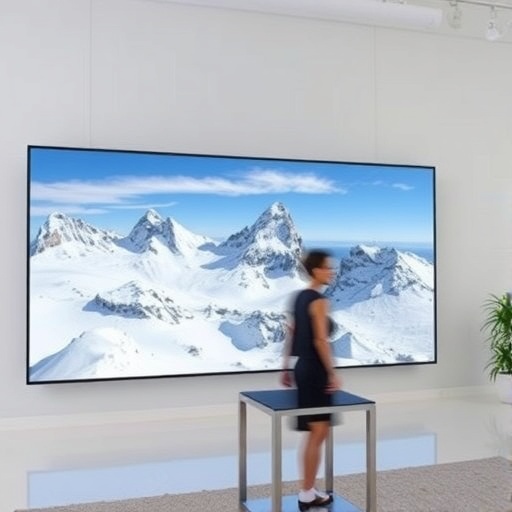In a groundbreaking advancement destined to reshape the future of visual technology, researchers have unveiled a novel glasses-free 3D display system that offers an unprecedented ultrawide viewing range, achieved through the innovative integration of deep learning and physical optics. This cutting-edge approach promises to overcome the longstanding barriers of traditional 3D display technologies, blending complex computational intelligence with optical design to deliver a truly immersive, naturalistic viewing experience without the need for wearable glasses.
At the heart of this breakthrough lies a sophisticated methodology named EyeReal, which harnesses the synergy of physical principles with an advanced AI-based mathematical model. The system utilizes a neural network endowed with ocular geometric encoding capabilities, allowing it to dynamically compute the optimal light field distribution around the viewer’s eyes in real time. This dynamic computation maximizes the effective utilization of the system’s space–bandwidth product (SBP)—a fundamental optical constraint that has traditionally limited the simultaneous expansion of image scale and viewing angle in 3D displays.
Traditional glasses-free 3D displays have struggled to balance large image sizes with wide viewing angles, constrained by physical optical limits that restrict how visual information can be presented across different spatial dimensions. EyeReal circumvents these limitations by continuously optimizing the presentation of the light field, ensuring that every photon contributes meaningfully to the perception of depth and parallax cues. This method enables the harmonious coexistence of wide viewing ranges and substantial image sizes—a feat previously unattainable within standard optical architectures.
Conventional approaches aiming to widen viewing angles have typically depended on increasingly complex hardware configurations, such as intricate optical elements or reliance on near-eye devices that reduce user freedom. In sharp contrast, EyeReal’s AI-driven strategy achieves wide-angle compatibility computationally. By integrating seamlessly with existing LCD display panels, this method eliminates the need for cumbersome hardware overhauls, significantly lowering barriers for commercial deployment and consumer adoption.
One of the most remarkable features of EyeReal is its ability to reconstruct real light fields that are meticulously optimized around the users’ eyes. This personalized reconstruction effectively eliminates common sources of visual discomfort in stereoscopic systems—the inter-pupillary distance (IPD) mismatch and the vergence–accommodation conflict (VAC). These issues have historically plagued extended reality (XR) devices, causing fatigue and limiting prolonged use. By resolving them, EyeReal paves the way for glasses-free 3D experiences that are both comfortable and visually compelling over extended periods.
The innovative SBP-utilization model formulated within EyeReal extends beyond single-user applications, offering scalable potential for multi-user environments. While the current implementation focuses on optimizing individual binocular viewing, future adaptations may incorporate techniques such as time multiplexing and directional backlighting. These extensions could address the challenges inherent in delivering tailored light fields to multiple viewers simultaneously, further expanding the technology’s practical relevance.
Importantly, EyeReal’s approach is not tethered solely to its current hardware prototype. The research outlines pathways for significant enhancements by integrating field-sequential color methodologies or deploying mini-LED backlighting technologies. These improvements would bolster optical efficiency and contrast ratios, facilitating deployments in varied ambient lighting conditions and sharpening visual fidelity—a critical factor for immersive 3D content consumption in diverse real-world settings.
The implications of EyeReal’s AI-empowered light-field generation extend beyond the immediate domain of display technologies. Its dynamic optimization principles could inform the development of large-scale, updatable holographic displays that require precise control over complex light fields. By balancing high spatial frequency, wide viewing angles, and depth perception within limited SBP constraints, EyeReal’s framework presents a universal solution that could revolutionize next-generation visual interfaces.
This fusion of AI with foundational physics signals a paradigm shift in how optical information is generated and presented. Rather than relying on static or hardware-centric solutions, the dynamic SBP-utilization model introduces an adaptable, context-aware means of producing light fields that directly respond to the viewer’s position and ocular geometry. This real-time adaptability marks a significant departure from legacy systems, which could neither efficiently account for individual variations nor support broad viewing zones effectively.
Moreover, EyeReal’s practical demonstration constitutes the first large-scale real-time 3D display showcasing seamless ultrawide viewing ranges—a milestone that delivers on the promise of truly natural and comfortable glasses-free 3D visualization. This breakthrough heralds potential new directions for entertainment, medical imaging, virtual reality, and beyond, where immersive 3D experiences are highly desirable but have remained limited by technical constraints until now.
The elegance and efficiency of the solution rest on its capacity to optimize SBP utilization, underscoring a scientific perspective with profound technological and commercial implications. In harnessing neural networks to adaptively tailor light distribution, the framework not only pushes the boundaries of optical design but also democratizes access to glasses-free 3D experiences by leveraging existing display infrastructures paired with advanced computation.
While significant challenges remain before commercialization, the path illuminated by EyeReal’s research invites intense exploration of AI-empowered optical computation as a cornerstone for the future of 3D displays. The convergence of deep learning with physical optics may well mark the cornerstone of post-glasses era visual media, enabling unprecedented naturalism, user comfort, and scalability in three-dimensional visualization.
As the scientific community digests this innovative approach, the prospects for myriad applications—from immersive gaming and holographic telepresence to advanced visualization in scientific research—appear boundless. EyeReal underscores the transformative power of integrating AI and physics, laying the foundation for an era in which glasses-free, natural 3D displays become a widespread reality.
Subject of Research: Glasses-free 3D display technology combining AI and physical optics for ultrawide viewing range.
Article Title: Glasses-free 3D display with ultrawide viewing range using deep learning.
Article References:
Ma, W., Zhao, Z., Zhao, C. et al. Glasses-free 3D display with ultrawide viewing range using deep learning. Nature (2025). https://doi.org/10.1038/s41586-025-09752-y
Image Credits: AI Generated
DOI: https://doi.org/10.1038/s41586-025-09752-y
Tags: computational intelligence in imagingdeep learning in visual technologyEyeReal methodology for 3D displaysglasses-free 3D display technologyimmersive viewing experiences without glassesneural networks in opticsocular geometric encoding techniquesoptical design advancementsovercoming traditional 3D display barriersreal-time light field distribution computingspace-bandwidth product optimizationultrawide viewing range innovations





